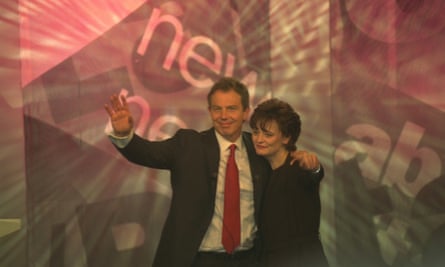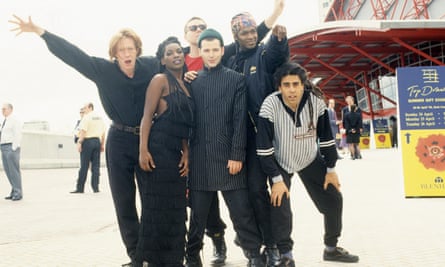It’s late in the evening on election night 1997, shortly after the enormity of the result has become clear; former Labour leader Neil Kinnock, under whom the party had begun its “long trek back towards electability”, is flanked by senior MPs Robin Cook and John Prescott.
Behind them, filling the cavernous space of the Royal Festival Hall, a joyous throng of Labour staff, volunteers and party members are singing, smiling and swigging from cans, all soundtracked by a thumping 4/4 beat. Kinnock, Cook and Prescott are making a game but a mesmerically awful attempt to join the fun.
First released in 1993, but only lightly grazing the Top 40 on its initial foray into the charts, a poppier remix of D:Ream’s Things Can Only Get Better spent four weeks at No 1 the following January. Two years on from that, it was co-opted for the launch of Labour’s five “pre-manifesto” pledges, written largely by Tony Blair himself. Something in the song’s message clearly resonated with Labour apparatchiks, or tested well with the party’s army of focus groups: by the time the election came around in May 1997, Things Can Only Get Better had displaced The Red Flag as New Labour’s election anthem, the feelgood sonic backdrop to rallies, photo opportunities and campaign adverts alike.
The purest distillation of its power can be found in a party political broadcast that aired shortly before polling day, which uses Things Can Only Get Better as its soundtrack, and now feels so gauche as to verge on self-parody. We see the letterbox of an anonymous front door flap open: on to the doormat drops a polling card, and a copy of the Sun declaring “ELECTION: 3 DAYS TO GO”. A man in a pale blue-green shirt picks up the polling card and turns it over thoughtfully: the camera never shows his face, but we are given the distinct sense of him musing on the card’s meaning.
A calendar ticks forward to election day: mind made up, our faceless hero strides out of the door, as if propelled by destiny, to be greeted by a carefully choreographed fever dream of English archetypes and aspirations just as the song’s thumping bassline kicks in. A middle-aged man in a red Mondeo nearly runs him over, then offers a grinning thumbs up; a Black woman selling flowers smiles pliantly and then, mesmerised, follows our hero down tree-lined streets while carrying a bunch of roses; alfresco diners at a kerbside restaurant stand and applaud as the camera tracks across them; a man carrying a bunch of balloons and a woman wearing roller skates join the procession; D:Ream’s chorus of gospel singers guide us towards aspiration and redemption. It is Jesus’s triumphal entry into Jerusalem, reimagined for a world of centre partings, chunky mobile phones and England losing to Germany on penalties.
In The Century of the Self (BBC), the documentarian Adam Curtis maps out the influence of Freudian psychoanalysis on 20th-century society and meaning, from Sigmund Freud’s earliest exploration of unconscious desires to advertising pioneer Edward Bernays (Freud’s nephew, inventor of the term “public relations” and the world’s first spin doctor) who weaponised those buried urges to drive political and marketing campaigns of uncanny power and foresight.
Curtis’s narrative culminates with Labour’s 1997 election victory, and in particular the use of focus groups by campaigners like Philip Gould (who had been an advertising executive) and Matthew Freud (a PR guru and Sigmund’s great-grandson). The open-ended conversations and bubble-like intimacy of the focus group offered pollsters a glimpse into the subconscious desires of swing voters; insights which in turn profoundly shaped New Labour’s policy positions and messaging. Curtis argues that the ascent to power of Tony Blair and Gordon Brown marked the end of democracy as a process guided merely by voters’ tribal identities or cost-benefit analyses of the manifestos on offer; instead, in 1997 the democratic process becomes a Freudian expression of the electorate’s unconscious desires, a reflection of how each candidate makes them feel.
That sentiment is captured no more potently than in the climax of Things Can Only Get Better and the electoral campaigns built around it: as the club-ready beats thump and a mass of choral voices drive us into hitherto-undiscovered realms of bliss, voting for Labour becomes not only a way to fix the ills of the country, but a way to transform ourselves, the transcendental power of the dancefloor transfigured to the ballot box.
Labour’s last-minute party political broadcast is steeped in this: by the time the crowd reaches the polling station, led by the faceless man in the blue shirt, the atmosphere is carnivalesque, a hallucinatory vision of some new Albion; the flower-seller gives the Tory candidate, a grey-haired old fogey standing stiffly by the door, a pinch on the cheek; voters stand back and gasp as our faceless Everyman makes his way to the ballot box. After casting his vote, the camera pans up to at last reveal this latter-day John Bull, the embodiment of the renewed spirit running through these sceptred isles. It is none other than Tony Blair himself, grinning back at us as the hi-hats lift us higher. With the music still pounding away, the screen fades to white.
after newsletter promotion
Where Blair stood, we’re now left with a two-word instruction written in his own handwriting – “Do it”. Seconds later, his autograph appears beneath. There’s a heady mix of connotations at play here, from the uneasy lure of Freudian desire-baiting to the gentle platitudes of self-help literature, and a quasi-messianic reliance on Blair’s charisma. But this combination of short, blunt imperative and euphoric overload also harks back unexpectedly to the earliest days of Chicago house. From Phuture’s Work It to Steve “Silk” Hurley’s UK chart-topper Jack Your Body or Free Yourself by Virgo, it’s noticeable how much of this music repeatedly iterates on precisely the same rhetorical template borrowed by Blair: a short, abstracted demand set to a thudding 128bpm kick drum; dancefloor catharsis and urgent command working hand in hand. There’s even a 1995 house pumper by Chicago producer Glenn Underground titled Do It. If New Labour’s campaign materials had instead spent 1997 asking the electorate Can You Feel It? no one would have batted an eyelid.
That linguistic similarity isn’t accidental. New Labour weren’t just hitching their wagon to dance music in a vague appeal to youthful credibility, but because the emancipatory energy of house music – from its roots in the queer Black clubs of Chicago to its latterday expression in the form of Things Can Only Get Better – spoke directly to the British voting public’s most powerful unconscious desires.

However different the sweat-drenched walls of the Warehouse in 1987 and the ballot boxes of the 1997 general election might seem, and however distinct the indignities of ingrained American racism and homophobia might be from the upheavals of the Thatcher years, both of these versions of house music speak to similar emotional states: a collective weight being cast off and disfranchised communities belatedly emerging from the shadows of an oppressive superstructure. “‘It’s difficult to remember now what Thatcher’s Britain felt like,” DJ Fabio told the Guardian in 2008, describing the birth of acid house in terms which could just as easily be applied to New Labour’s ascent to power. “A lot of people were searching for something, for a way out.”
After staying up through the night to witness the 1997 results coming in, Labour campaigner John O’Farrell details his journey home as a kind of spectral, rainbow-flecked reverie, with “the dawn sun shining on the Houses of Parliament, the new gold paint glistening and reflecting in the Thames … it really did look like a completely different place” – a dreamlike scene which is likely to be instantly recognisable to anyone who’s rolled out of the Stygian gloom of a nightclub at 6am, only to find the sun blazing and the everyday world resuming around them.
After 18 years of Thatcher’s Victorian values, is it any surprise that by 1997 the British public felt like throwing their hands up in the air? Or, indeed, that New Labour would gravitate towards the emotive power of dance music, right down to its most granular stylistic tics, in an attempt to leverage that sentiment for electoral purposes? Forget about the myopic parochialism of Britpop, with which Blair and others are far more regularly and erroneously associated: the 1997 election was won by house music.

